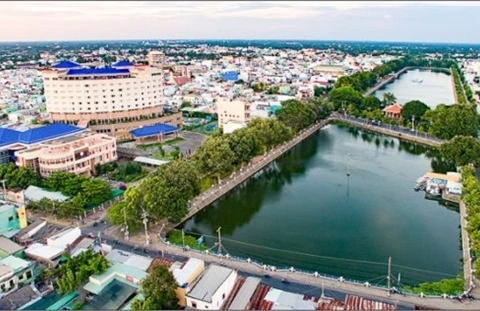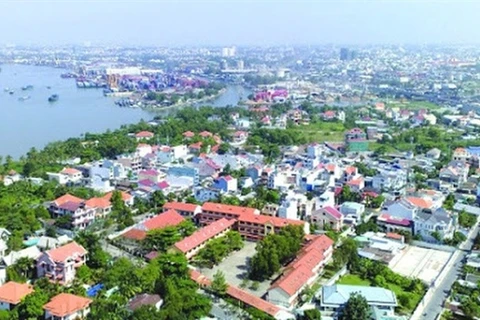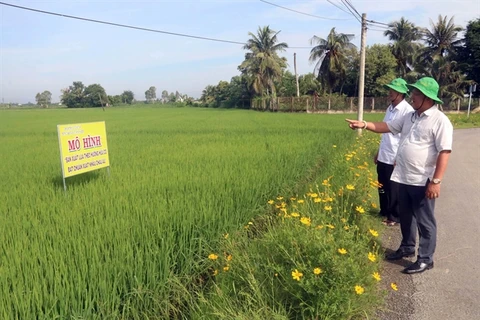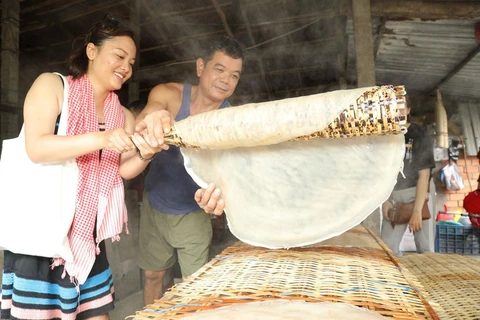 A fruit orchard that was formerly an unproductive rice field in Tien Giang province’s Cho Gao district. (Photo: VNA)
A fruit orchard that was formerly an unproductive rice field in Tien Giang province’s Cho Gao district. (Photo: VNA) Tien Giang (VNS/VNA) - The Mekong Delta province of Tien Giang plans to turn 7,700ha of unproductive rice fields into high-value crops to adapt to climate change and natural disasters in the 2020-2025 period.
The province, which is the country’s largest fruit producer, will convert nearly 5,000ha of unproductive rice fields to fruit cultivation, mostly in areas between National Highway No. 1 and Trung Luong-My Thuan expressway, according to the provincial Department of Natural Resources and Agriculture.
About 700ha will shift to vegetables in areas that have traditionally cultivated vegetables, mostly in Chau Thanh district.
In addition, farmers on about 1,300ha will rotate growing rice in the rainy season and vegetables in the dry season on the same fields in Cai Be and Cai Lay districts and Cai Lay town.
Around 700ha of rice will be turned into aquaculture areas in Cai Lay district and Cay Lay town.
Localities will help farmers choose the most suitable crops to grow in their fields, and to improve productivity, agriculture extension activities as well as provision of advanced techniques will be offered to farmers.
The production of crop seeds and seedlings will also be inspected to ensure quality.
Nguyen Van Man, director of the department, said the province would focus on issues such as market information, agricultural product consumption, trade promotion, and origin traceability to develop sustainable production.
The province will boost linkages among farmers, scientists, companies and local authorities in agriculture to improve efficiency.
It will also expand agricultural co-operative models that have operated effectively, he said.
The province has 80 linkage models among farmers and companies for producing and consuming agricultural products on a total area of 13,000ha.
The 80 models produce a total of 121,800 tonnes of agricultural products worth 607 billion VND (26.2 million USD) a year.
The province is also seeking investors in agricultural production and rural area development.
Tien Giang, which was heavily hit by saltwater intrusion in the dry season, has converted more than 13,700ha of rice to other high-value crops this year.
The profit from growing high-value fruits like durian, jackfruit, mango and green-skin and pink-flesh grapefruit is 9-12 times higher than that of rice.
Tran Van Toan, who has shifted his 2ha rice fields to dragon fruit in Go Cong Dong district’s Kieng Phuoc commune, said his family had produced three rice crops a year, but did not have a high income.
“Drought, saltwater intrusion and climate change became more severe and caused damage in recent years and local authorities encouraged rice farmers to switch to other crops,” he said.
Under the encouragement of local authorities, he switched to dragon fruit. He now earns a profit of 500 million VND (21,600 USD) a year, he said.
The province has more than 82,000ha of fruits and 57,000ha of vegetables. It has 179,843ha of farmland, accounting for 71.6 per cent of its total area.
Saltwater prevention
Saltwater intrusion in the 2020-2021 dry season is expected to arrive earlier this year, affecting the 2020-21 winter-spring crop, the summer-autumn crop, and fruit orchards in the western area of Tien Giang, according to the provincial People’s Committee.
Local departments, agencies and localities plan to upgrade saltwater-prevention works, transport fresh water and store fresh water for agricultural production and household use.
Farmers will also receive guidance in how to store fresh water and use fresh water efficiently.
In recent years, saltwater intrusion and drought caused damage to agriculture in the dry season, especially fruit cultivation. As a result, farmers changed the growing schedules of rice and other short-term crops, or stopped growing them in certain periods.
To protect perennial fruits from natural disasters, they have stored fresh water and built saltwater-prevention dams.
Man, director of the Department of Agriculture and Rural Development, said the province has upgraded saltwater-prevention dams and sluices, and built new ones in major agricultural production areas.
In Cai Lay district, the islet communes of Tan Phong and Ngu Hiep grow specialty fruits like durian and rambutan for domestic consumption and export.
The two communes have more than 2,600ha of fruits. In the last dry season, many fruit orchards on the two communes died or were severely affected by saltwater intrusion.
For the 2020-2021 season, the province has spent 55.3 billion VND (2.38 million USD) to build eight temporary saltwater-prevention dams on Ngu Hiep and 20 temporary saltwater-prevention dams on Tan Phong.
The department, in co-operation with the two communes, plans to collect and store fresh water in the dry 2020-2021 season to protect agricultural production and the lives of local people./.
VNA

























